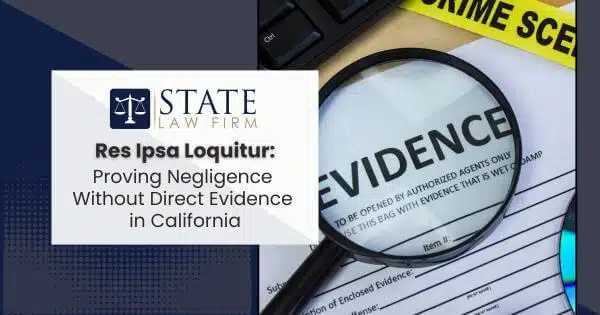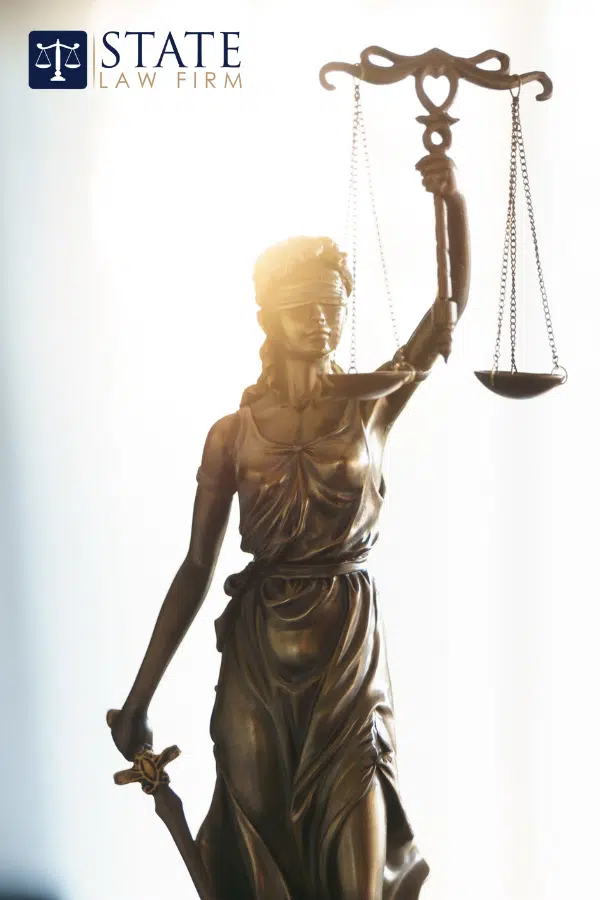When someone is injured and there’s no apparent eyewitness or video footage, does that mean there’s no case? Not necessarily. In California, the legal doctrine of res ipsa loquitur—Latin for “the thing speaks for itself”—can allow injured parties to hold negligent actors accountable, even without direct evidence. It’s a powerful tool in personal injury law that helps level the playing field when the cause of an injury is apparent, even if the details are not.
According to the National Center for State Courts, over 400,000 personal injury cases are filed in the U.S. each year, with many relying on circumstantial evidence to establish liability. (source) In California, the doctrine of res ipsa loquitur has become a vital argument in cases ranging from surgical mishaps to falling objects—any situation where an injury would not normally occur without the negligence of someone.
At State Law Firm, we’re a boutique personal injury practice in Sherman Oaks run by young, driven attorneys who are evolving into full-fledged litigators. We know how to navigate complex legal strategies, such as res ipsa loquitur, to help our clients fight for justice, even when the evidence isn’t laid out in black and white. Whether you were injured in a setting where negligence seems obvious but unproven, or you simply need guidance on building your claim, we’re here to help.
Need proof for your claim? Learn how to request traffic camera footage in California—one of the many tools we use to strengthen injury cases like yours.
In this guide, we’ll break down what res ipsa loquitur means under California law, how to use it effectively in personal injury cases, and the challenges that can arise. Let’s get started.
Introduction to Res Ipsa Loquitur in California Law
Res ipsa loquitur is a legal doctrine that allows plaintiffs to prove negligence through circumstantial rather than direct evidence. The phrase, which means “the thing speaks for itself,” applies when the very nature of an accident implies negligence, like a surgical instrument left inside a patient or a light fixture falling from a ceiling.
Under California negligence law, this principle helps plaintiffs when traditional forms of proof, such as eyewitness testimony or surveillance footage, are unavailable. It shifts the focus to whether the incident could reasonably have occurred without negligence.
This legal tool is especially helpful in complex personal injury cases, where the responsible party may deny fault or claim the cause of injury is unknown. But just because the evidence isn’t obvious doesn’t mean your rights should go unprotected.
The Elements of Res Ipsa Loquitur: What You Need to Establish
To invoke res ipsa loquitur in California, plaintiffs must meet three key elements:
- The incident is of a type that ordinarily does not happen without negligence.
- The instrumentality or agent that caused the injury was under the defendant’s exclusive control.
- The plaintiff did not contribute to the cause of the harm.
When these elements are present, the court may allow the jury to infer negligence from the circumstances alone. This shifts the burden to the defendant to explain how the injury occurred without fault.
Pro Tip: Just because you can’t see the negligence doesn’t mean it didn’t happen. Work with a legal team that knows how to uncover it through innovative strategy and experience.
How Res Ipsa Loquitur Applies in Personal Injury Cases
In personal injury law, res ipsa loquitur frequently arises in cases involving:
- Medical malpractice (e.g., foreign object left in a patient’s body)
- Slip and falls (e.g., a ceiling tile falling in a grocery store)
- Product liability (e.g., defective appliances catching fire)
- Construction site injuries (e.g., unsecured materials falling from above)
Imagine you’re walking through an apartment complex and a loose balcony railing gives way, causing a fall. You may not know precisely who failed to maintain the railing, but the fact that it gave way can imply negligence under the doctrine of res ipsa loquitur.
Our attorneys at State Law Firm have used this doctrine to strengthen cases where the facts seemed stacked against the injured party. That’s the advantage of working with a team that thrives on tough, fact-light cases.
Key Case Laws Shaping Res Ipsa Loquitur in California Jurisprudence
California courts have long recognized the value of res ipsa loquitur, and several key decisions continue to shape its application today:
- Ybarra v. Spangard (1944) – A landmark California Supreme Court case where the plaintiff awoke from surgery with unexpected injuries. The court held that multiple defendants could be held accountable under the doctrine of res ipsa loquitur because the injury wouldn’t have occurred without negligence.
- Zentz v. Coca Cola Bottling Co. (1952) – The court permitted an inference of negligence when a Coke bottle exploded in the plaintiff’s hands, suggesting faulty handling or manufacturing.
- Brown v. Poway Unified School District (1993) – Clarified limits of the doctrine in cases where control or causation could not be attributed.
Legal Insight: These cases show that res ipsa loquitur isn’t a blanket rule—it requires close analysis of the facts and the defendant’s control over the circumstances.
The Role of Expert Testimony in Supporting Res Ipsa Loquitur Claims
Even when the facts seem to “speak for themselves,” expert testimony can make or break a res ipsa claim.
Experts help establish:
- What happens typically in the situation at issue
- Why the injury is likely to occur absent negligence
- Who had control over the injury-causing instrument or process?
In medical or technical cases, a qualified expert can help the jury understand complex processes and why a deviation suggests negligence.
At State Law Firm, we collaborate with vetted expert witnesses who explain technical failings in a way judges and juries can understand. That’s part of how we make your story clear—even when the details are buried beneath layers of procedure.
Pitfalls and Challenges When Using Res Ipsa Loquitur as a Defense or Claim Strategy
While res ipsa loquitur can be powerful, it’s not always a slam dunk. Common challenges include:
- Proving exclusive control – If multiple parties could have caused the harm, it weakens the argument.
- Overcoming alternate explanations – Defendants may offer plausible non-negligent causes for the injury.
- Establishing lack of contributory fault – If the injured person may have caused or worsened the harm, the doctrine may not apply.
Some defendants also attempt to neutralize res ipsa loquitur by demonstrating that reasonable care was exercised, even in the event of a tragic outcome.
Pro Tip: Success with res ipsa often hinges on thorough preparation. Gathering early evidence, such as maintenance logs, internal reports, and even traffic camera footage, can help tip the scales in your favor.
Leveraging Res Ipsa Loquitur to Strengthen Your Negligence Case in California
If you’ve been injured and don’t have direct evidence of how it happened, don’t assume you’re out of options. Res ipsa loquitur is one of the many tools that can turn circumstantial facts into a compelling negligence claim.
At State Law Firm, we’re proud to take on the complex cases—the ones where other attorneys might walk away because the proof isn’t apparent. We dig deeper, think strategically, and work to get the best outcome for our clients.
If you’re wondering whether res ipsa loquitur could apply in your case, now’s the time to act. Schedule a free consultation and let’s talk through your options.


